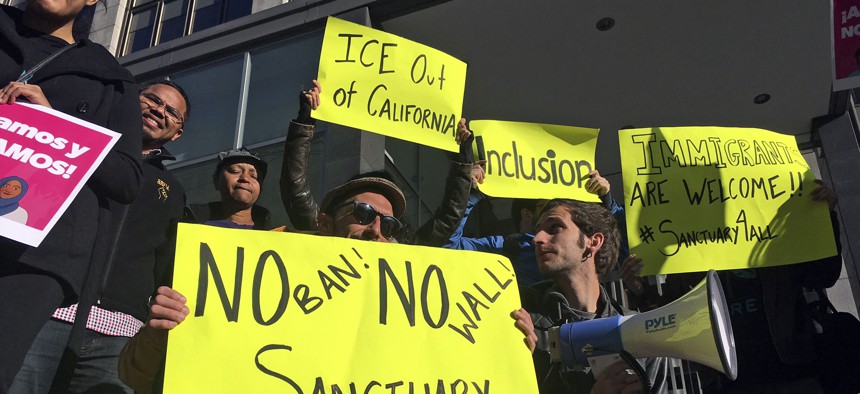California Didn’t Become More Dangerous After It Passed a Sanctuary Law, Study Says

Protesters stand outside a courthouse in San Francisco during a hearing for a lawsuit challenging President Trump's 2017 executive order to withhold funding from communities that limit cooperation with immigration authorities. AP Photo/Haven Daley
Law enforcement warned that California’s sanctuary policy would endanger public safety. New research found that hasn’t been the case.
When California passed its sanctuary law in 2017 prohibiting police cooperation with federal immigration authorities, it ignited an uproar from some law enforcement and local governments officials who argued the policy would lead to an uptick in crime.
But a new study by researchers from the University of California, Irvine found that the state hasn’t become more dangerous as a result of its immigrant-friendly posture. In the first systematic analysis of California’s crime rates since the sanctuary designation went into effect in 2018, researchers Charis Kubrin and Bradley Bartos compared property and violent crime rates after SB 54’s implementation to a weighted model built on state crime data from across the country. They found the law made no difference.
“There have been a lot of critiques of SB 54, and immigration policy more generally, that argue crime will go up if we create places with sanctuary status,” Kubrin said. “We didn’t find that to be the case.”
SB 54, also known as the California Values Act, was passed in 2017 in response to President Trump’s promises to ramp-up immigration enforcement and crack down on jurisdictions with sanctuary policies. In essence, SB 54 bars state and local law enforcement agencies from using “money or personnel” to participate in immigration enforcement.
The law doesn’t allow the law enforcement to cooperate with ICE detainers, which are requests sent to local jails asking for a 48-hour hold after an individual’s scheduled release so that ICE can determine if the person is in the country unlawfully (during that time, ICE may take that person into federal custody). SB 54 does, however, allow for the transfer of individuals suspected of being undocumented to ICE custody if they have been convicted or charged with certain serious crimes, including assault, rape, robbery, murder, and gang-related offenses.
Many sheriffs have blamed the law for crimes committed by people with ICE detainers after their release from jail. Last month, the Orange County Sheriff’s Department released data that showed over 2,100 people with ICE detainers were released from jail in 2018 and 2019 without a notification sent to ICE. Of those, 411 were rearrested on other charges, which Sheriff Don Barnes said proved that “SB 54 has made our community less safe.”
Kubrin said that even though her study found SB 54 had no impact on crime, it did look at the state as a whole, meaning crime could have gone up in certain communities and down in others. But she added that Orange County’s data doesn’t say anything definitive about SB 54. “These kinds of policy evaluations are really challenging because you want to isolate the impact of a particular policy when lots of other factors relate to crime,” Kubrin said, noting that year-over-year fluctuations in police-community relations, drug use, homelessness rates, and gang activity could also lead to changes like what Orange County saw. “Orange County did not do a policy evaluation. They connected crime rates to SB 54 without ruling out any other factor.”
The law hasn’t just been criticized by the sheriff’s office. Orange County Board of Supervisors Chairwoman Michelle Steel, who in 2018 led the county to join a federal lawsuit against SB 54, said in a statement that the law “ties the hands” of law enforcement. “This law has resulted in an increase in crime and a decrease in the safety of our communities,” she said.
One federal lawsuit by the Trump administration against SB 54 ultimately proved unsuccessful, as have other suits brought by jurisdictions that want to continue working with ICE. The California State Sheriffs Association, one of the most vocal opponents of SB 54 and a supporter of the federal lawsuit against the law, did not return a request for comment regarding the recent study.
But the Trump administration has not given up its legal fight against sanctuary policies in California and other states. In February, the Justice Department again sued California, New Jersey and King County, Washington.
A 2019 report found that several sheriff departments in California, including Orange County, were “exploiting an exception” in the sanctuary law by publicly posting the release dates of people in jail, giving ICE agents an indirect heads up about undocumented immigrants in their holding cells. The Asian Americans Advancing Justice-Asian Law Caucus, a San Francisco-based group, also found that some sheriff departments were simply disregarding certain provisions of the law by questioning detainees about their immigration status and allowing ICE to operate in their facilities.
Kevin de León, the former state senator who authored the law, told NPR in 2018 that he was inspired to write the law to stop the kind of actions described in the 2019 report. "I wanted to make sure that our local police officers, our sheriffs, were not a cog in the Trump deportation machine, separating innocent mothers from their children and children from their fathers,” he said.
Numerous studies in the past five years have found that undocumented immigrants commit crimes at much lower rates than native-born Americans. Other studies have found that communities with large immigrant populations do not have higher crime rates. Two 2019 studies studied crime specifically in sanctuary cities and found similar results to Kubrin’s study.
Cynthia Buiza, the executive director of the California Immigrant Policy Center, said that the new research “reinforces that there is no correlation” between immigrants and public safety risks. “We’ve always believed that making sure that immigrants feel protected in the communities where they live is safer for all of us,” she said. “This law took a long time to get done, it was vetted thoroughly, and a rigorous debate ensued with law enforcement. It wasn't arbitrarily enacted. Research now shows the righteousness of that process and this law.”
Emma Coleman is the assistant editor for Route Fifty.
NEXT STORY: First Coronavirus ‘Containment Zone’ in U.S. Established in New York State






